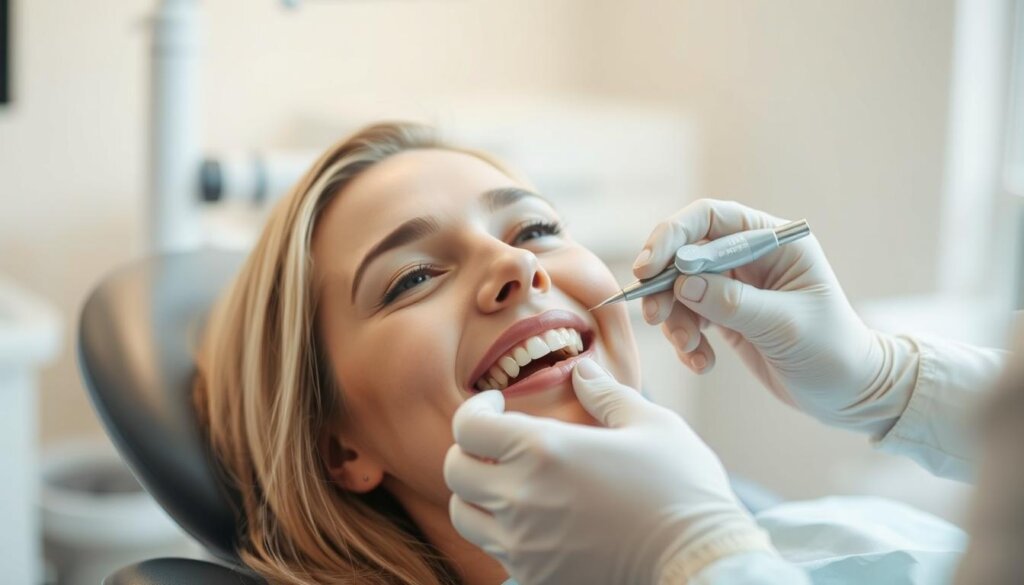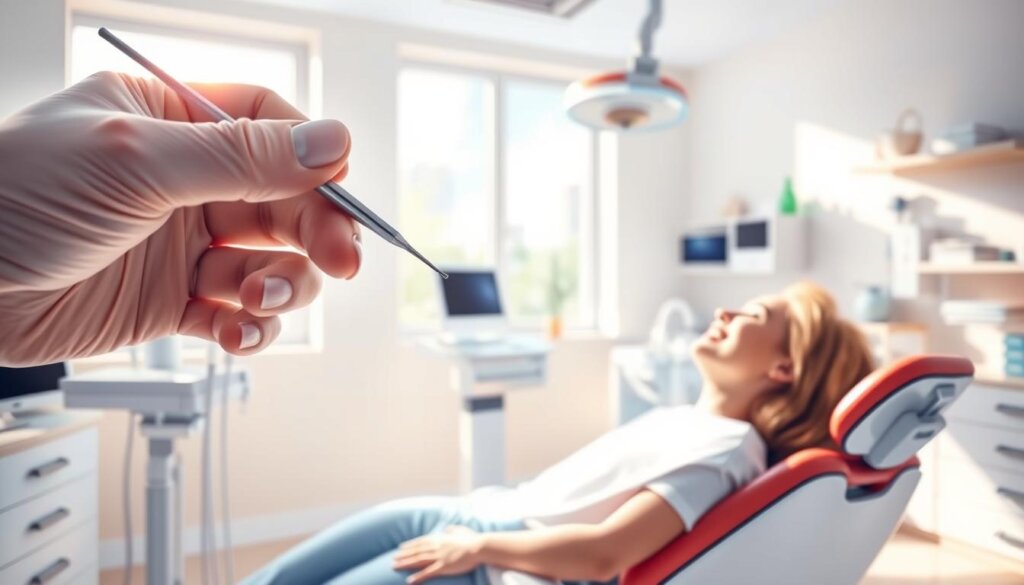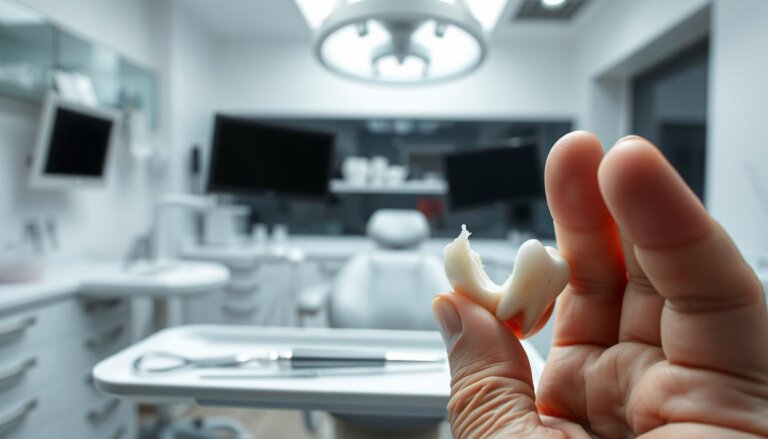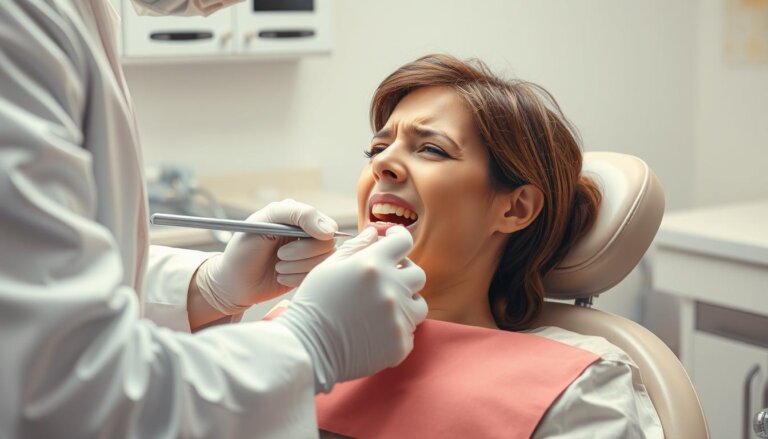Does a Dental Cleaning Hurt?
Many adults in the U.S. are scared of going to the dentist. They think it will hurt. This fear is common and shows we need to explain what a dental cleaning is like. Dental cleanings are key to keeping your mouth healthy. They shouldn’t cause you pain. But many people still wonder, “Does it really hurt to get a dental cleaning?”
The feeling you get during a dental cleaning depends on you. For some, it’s a smooth path to having healthier teeth without any pain. But, if you don’t go to the dentist often, you might feel some discomfort. The scraping sounds scary, but it usually just means your teeth are sensitive.
Dentists are great at making cleanings less scary. They use pain relievers and special toothpaste to lessen any discomfort. Regular brushing and using a soft toothbrush can make your gums ready for your next visit. This reduces the chance of feeling pain.
So, the idea of dental cleaning pain can change. It’s not about fear, but about preventing pain and taking care of your teeth. Taking care of your mouth can be easy and not painful. You just need to follow good dental habits.
Key Takeaways
- The fear of pain during dental cleaning is prevalent, but actual experiences vary widely.
- Maintenance of oral health is crucial for minimizing discomfort during cleanings.
- Individual sensitivity and dental condition play significant roles in perceived pain.
- Professional techniques and preemptive measures are effective in reducing pain.
- Regular dental visits contribute to a more comfortable and healthful oral care experience.
What to Expect During a Dental Cleaning
Getting a dental cleaning is a step towards healthy teeth and gums. It helps stop future dental problems. Here are some dental cleaning tips to make your visit better.
The Cleaning Process Explained
The first step is checking your mouth. Next, plaque and tartar are removed. Dentists use special tools called scalers for this.
Scaling can feel weird, but it’s important. Then, they polish your teeth with high-speed brushes. This makes your teeth feel super clean.
Tools Used by Dental Professionals
Dentists have cool tools to clean your teeth gently. These tools help in reducing dental cleaning discomfort and ensure your teeth are well-cleaned. They include:
- Ultrasonic Instruments: These use vibrations to get rid of tartar and plaque softly.
- Scalers: These are for carefully removing tartar.
- Polishers: After removing tartar, these make your teeth smooth and shiny, helping you keep them clean.
Knowing what tools and steps are involved can make you less worried. It helps you get ready for a smoother dentist visit.
Common Concerns About Pain
Many people feel nervous about dental visits due to fears of pain. They worry about the sensitivity they might feel, especially if they have sensitive gums or a lot of tartar. It’s important to know what is true and what is not to help ease those fears and keep people going to their dentist regularly.
Some discomfort during a dental cleaning is possible. This is especially true for deep cleaning treatments. But, the equipment and methods used have improved. They aim to make dental cleaning comfortable for everyone.
Sensitivity and Discomfort Levels
If you have sensitive teeth or dental conditions, you might feel more discomfort during your cleaning. Modern dentistry offers ways to reduce this discomfort greatly. They often use local anesthetics or numbing gels. This makes the cleaning manageable, even for people who are really anxious about it.
Myths vs. Reality
Some people think dental cleanings always hurt a lot and, because of that, they avoid getting the care they need. It is very important to replace those myths with true information. Here, you can see the difference between common myths and the real facts about dental cleanings:
| Myth | Reality |
|---|---|
| Cleanings always hurt | Minor discomfort might occur, but severe pain is not typical |
| Cleanings are only necessary for visible problems | Regular cleanings prevent the development of serious oral health issues |
| Only children are scared of dental cleanings | Patients of all ages can experience dental cleaning anxiety |
By clearing up these myths and giving clear information, patients can feel more at ease. This helps them be ready for their dental cleanings.
Factors That Influence Pain Perception
It’s key to understand what affects pain feeling during a dental cleaning to lessen it. Pain can vary a lot from person to person during cleanings. Several factors play into this.
Individual Pain Tolerance: Each person feels pain differently, which changes how they handle dental cleaning. For some, it’s no big deal, but for others, it can hurt a lot. Dentists need to figure out a patient’s pain level early on to adjust their cleaning technique.
Existing Dental Conditions: If you already have dental problems like gum disease or tooth decay, cleaning might hurt more. These issues can make your mouth more sensitive. Dentists often need to clean these spots more gently to keep pain low.
Frequent symptoms related to heightened pain perception include: - Increased sensitivity during cleaning around affected teeth or gums. - Discomfort when dental tools contact inflamed or receding gums. - Noticeable pain during the removal of tartar and plaque, especially if it's extensive.
To help lessen pain for patients, these points are vital. Knowing about different pain tolerances and existing dental problems lets dentists customize their care. This makes the cleaning experience easier and less scary for patients.
- Assessment of individual pain thresholds before the cleaning process.
- Adjustment of cleaning techniques to cater to sensitive areas.
- Use of numbing agents or mild anesthesia when necessary.
By taking these steps, dentists can make a care plan that fits each patient’s needs. This improves how satisfied patients are and reduces pain during cleaning.
Before Your Appointment: Preparing for Dental Cleaning
Getting ready properly is key for a good dental cleaning visit. By taking charge and staying informed, you can really help make your dental cleaning better and more comfortable. Here are some helpful dental cleaning tips designed to minimize dental cleaning pain and make you happier with the process.
Communicating with Your Dentist
Talking openly with your dentist is super important. It helps tailor your visit to your exact needs. If you let them know about any past bad experiences or discomforts, like sensitivity, it helps a lot. This talk before your visit can lead to less pain and worry.
What to Discuss
- Tooth Sensitivity: Make sure to tell them if cold or hot things make your teeth hurt, so they can pick the right tools and methods.
- Bleeding Gums: Say something if your gums bleed when you brush or floss.
- Dental Anxiety: It’s okay to talk about any dental fears you have; your dentist can help calm those fears.
- Pain Management Preferences: Discuss your pain control likes if you have them. Knowing this, your dentist can plan better before starting.
These talks aren’t just to ease pain, but they help create a visit that’s right for your health and comfort. Giving your dentist all the details helps them to give you a kind and efficient cleaning, thus minimizing dental cleaning pain.
The Role of Anesthesia in Dental Cleanings
Using anesthesia in dental cleanings helps with pain and fear. Many people get nervous about dental cleanings. But, modern anesthesia methods can make it a lot easier. Knowing about different anesthesia types helps patients feel ready for dental cleanings.
Types of Anesthesia Available
Here are some anesthesia types used in dental cleanings:
- Topical Numbing Gels – Put right on the gums, these gels help with minor pain.
- Local Anesthesia Injections – These shots numb the area around your teeth. They are good for more painful procedures.
- Sedation Options – This includes nitrous oxide, also known as “laughing gas.” It’s used to calm patients who are very anxious.
- For patients who find even a little pain hard to handle.
- For people who are really anxious about getting their teeth cleaned.
- During deep cleanings, which might be more uncomfortable.
Dentists look at each patient’s needs to choose the best anesthesia. This tailored approach makes dental cleanings easier and less scary. You should talk openly with your dentist about what worries you. This way, your dental visits can be as comfortable as possible.
How to Minimize Discomfort During Cleaning
To feel better during dental cleanings, it’s crucial to use techniques aimed at reducing dental cleaning discomfort. These methods help patients relax and lessen pain. This makes the cleaning feel easier to handle.
Starting to relax before you even get to the dental office is easy. You can listen to calm music or meditate for a short while. This helps you feel peaceful. Here are a few smart dental cleaning tips to make things more comfortable:
- Talk to your dentist about numbing options if cleaning feels too harsh.
- With your dentist’s okay, taking an anti-inflammatory medicine before your visit can ease swelling and pain.
- Look for a dental office that uses the latest, gentler tools for cleaning. This makes the experience less stressful.
Reducing dental cleaning discomfort also comes from good breathing techniques. Breathing deeply and focusing can distract you from the cleaning. It also helps your muscles relax, lowering stress:
- Deep Belly Breathing: Breathe in through your nose deep into your belly, not just your chest, and breathe out slowly from your mouth.
- Rhythmic Breathing: Find a breathing rhythm that’s comfortable, like counting to five for each inhale and exhale. Keep this up during the cleaning.
By using these methods, patients and dentists can make dental cleanings a lot less scary and more comfortable.
Aftercare Following a Dental Cleaning
It’s key to follow dental cleaning discomfort aftercare to keep your teeth healthy. Listening to your dentist’s advice helps a lot. Both their professional tips and your daily mouth care are crucial for your comfort and dental health.
Post-Cleaning Sensitivity
Feeling a bit sensitive after a cleaning is normal but it doesn’t last long. To lessen this feeling, stay away from very hot or cold foods for a while. Using a soft toothbrush and maybe some pain medicine can help too. These dental aftercare tips make recovery easier and reduce sensitivity.
Maintaining Oral Hygiene
After a cleaning, it’s really important to take good care of your mouth. Brushing and flossing a lot can speed up healing and stop tartar from coming back. This makes your teeth less sensitive and future cleanings easier.
Following these steps will make your mouth healthier and cut down on dental cleaning discomfort:
- Brush twice daily with fluoride toothpaste.
- Floss daily to remove plaque and tartar.
- Use a mouthwash to kill germs and protect your teeth.
Addressing Anxiety Related to Dental Visit
Understanding dental cleaning anxiety is key for getting patients to see how vital regular checkups are. By recognizing the fears that stop people from going to the dentist, we can find ways to help them get past those fears.
Techniques for Managing Fear
Good communication is crucial in dealing with dental anxiety. It lets dental professionals make changes to procedures to ensure comfort and lessen fear. Techniques like guided imagery and offering sedation options also help make the dental visit more relaxing.
Importance of Regular Dental Visits
Going to the dentist regularly is important for both dental and overall health. Teaching patients about the benefits and need for regular visits can make the procedures less scary and reduce stress.
| Technique | Benefit |
|---|---|
| Guided Imagery | Reduces stress and anxiety during cleaning |
| Sedation Dentistry | Offers pain-free, relaxed dental experience |
| Regular Consultations | Prevents complex dental issues, reduces future anxiety |
By tackling dental cleaning anxiety and highlighting the importance of regular dental checkups, we build a well-informed patient community ready to keep their oral health at its best.
The Benefits of Routine Dental Cleaning
Routine dental cleanings are vital for dental health maintenance. They prevent problems that could affect your overall health.
The main benefits of dental cleanings are stopping serious dental problems. By removing plaque and tartar regularly, you avoid gum disease and decay. These cleanings also help keep your overall wellness in check.
- Preventing Serious Dental Issues: Dental cleanings keep plaque away, lowering the risk of gum disease and decay. Finding and treating small issues early stops them from becoming bigger problems.
- Saving Money on Future Dental Work: Regular cleanings help avoid costly future dental treatments. Early problem detection means you might not need expensive care later.
In short, regular dental cleanings are crucial for keeping your mouth healthy and saving money. They protect your oral health today and reduce the need for major treatments later. Cleanings are a key part of preventive care.
Pediatric Dental Cleanings: Special Considerations
It’s essential to address the unique needs of kids during dental visits. This helps them care about their oral health for life. Focusing on lessening the pain of dental cleaning for kids involves techniques that work well while being kind to their young minds.
Creating a welcoming space for kids helps ease their fears during cleanings. Dentists and their teams make the dental office friendly and speak in ways that kids find comforting. They explain things simply, often using stories or comparisons to make the tools and steps less scary.
- Distractive techniques such as playing children’s favorite movies or music.
- Offering toys or allowing children to bring a comfort item from home.
- Positive reinforcement through stickers or small rewards post-cleaning.
Starting dental care early is super important. It’s not just about avoiding cavities when they’re young. It sets kids up for strong teeth as adults. Regular cleanings and spotting problems early can stop bigger issues later. This makes dental visits smoother for kids and more cooperative.
- Teaching proper brushing and flossing techniques tailored to each age group.
- Regularly updating parental guidance on children’s dental needs and preventive care.
This approach reduces pain during cleaning for the kids. It also creates a learning space that both kids and parents value. Dentists focusing on kids’ oral health are key in teaching habits that last a lifetime.
Exploring Alternative Cleaning Options
Nowadays, oral health choices include many methods beyond the old ways. These new options make cleaning teeth both easy and effective. They cover alternative dental cleaning methods and ways to look after your teeth at home.
There are two main advancements in dental care: products you can use at home and laser treatments at the clinic. Home dental care kits are now more popular. They are easy to use. People like them because they can help keep teeth clean between dentist visits.
| Cleaning Method | Typical Use | Comfort Level |
|---|---|---|
| Traditional Dental Cleaning | Professional Clinic | Moderate to Low |
| Laser Dental Cleaning | Professional Clinic | High |
| Home Dental Kits | At-Home | High |
While it’s great to use home dental care for its simplicity, it’s not the same as going to the dentist. But, using these home methods regularly plays a big part in keeping teeth healthy. They work well alongside visits to your dentist.
Laser cleanings are a new way to keep teeth healthy. They’re quiet and gentle. This can be great for those who don’t like traditional cleanings. Many people find this method less scary and more comfortable.
To sum up, when looking at alternative dental cleaning methods, think about what each offers. Whether you choose laser treatments or a home dental care routine, your choice should make your dental health better and fit your life.
The Truth About Whitening Treatments During Cleaning
Many people want a whiter smile and choose dental cleaning and whitening treatments. It’s key to know the good and bad sides of these treatments, including teeth sensitivity after whitening. We’ll look into the differences and sensitivities of professional and do-it-yourself whitening, helping you know what to expect.
After whitening, teeth might get sensitive. Whether it’s a treatment at the clinic or a home kit, the bleaching agents used can make your enamel more porous. This can make your teeth more sensitive to hot or cold things. Professional treatments often use stronger bleaching agents which can lighten your teeth more but may also make them more sensitive. If you already have sensitive teeth, talk to your dentist before whitening.
Professional vs. At-Home Whitening
- Professional Whitening: This is done at dental clinics and gives quick, visible results. Dentists use strong peroxide gels but apply them carefully to prevent gum irritation. Though it works well, it might increase teeth sensitivity.
- At-Home Whitening Kits: These kits have weaker peroxide solutions you can use yourself. But, using them wrong can give uneven whiteness or hurt your mouth. They’re easy and cheap but take longer to whiten teeth than a dentist’s treatment.
When thinking about dental cleaning and whitening, consider both the upsides and the risk of more teeth sensitivity after whitening. Talk to your dentist to pick the best option for your dental health and looks.
Real Patient Experiences with Dental Cleanings
Learning from real-life stories about dental cleanings offers deep insights. By exploring patient feedback on dental cleaning and sharing dental cleaning experiences, newcomers get a clear picture of what’s ahead. This knowledge helps them get ready for their own dental visits.
| Age Group | Feedback | Impact on Dental Health |
|---|---|---|
| 20-30 years | Mostly positive, appreciates the thoroughness | Significant improvement in gum health |
| 31-40 years | Mixed feelings due to sensitivity | Moderate improvement, advised regular visits |
| 41-50 years | Highly satisfied, less discomfort than expected | Marked reduction in plaque and potential diseases |
| Over 50 years | Appreciates professionalism, gentle approach | Helped in delaying or preventing serious dental issues |
These dental cleaning experiences highlight the importance of custom care. Different ages have unique needs and sensitivities. Patient feedback on dental cleaning helps both patients and dentists. It improves care and sets realistic expectations for future visits.
How Often Should You Get a Dental Cleaning?
It’s key to know how often to get your teeth cleaned for good oral health. How often you need it can be different for everyone. This is because people have their own individual dental care needs. Normally, dentists suggest getting cleanings every six months to once a year. Your dentist will decide what’s best for you based on several personal factors.
A dental cleaning frequency that’s right for one person might not be right for another. It needs to be tailored to fit your own oral health status and risks.
| Condition | Recommended Cleaning Frequency |
|---|---|
| Standard Risk | Every six months |
| High Risk for Dental Disease | Every three to four months |
| Low Risk | Once a year |
People at higher risk for gum diseases or those who get plaque build-up fast might need cleanings more often. On the other hand, those with great oral hygiene and lower risk factors might not need them as much.
The aim is to adjust the dental cleaning frequency to meet everyone’s individual dental care needs well. This helps everyone keep their mouth healthy and clean.
The Importance of Choosing the Right Dentist
Finding the right dentist is key to keeping your teeth and gums healthy. The right choice can make a big difference. You’ll get care that is both personal and caring. A good dentist builds trust and makes you feel safe, which is important for a worry-free visit.
A great dentist really understands their patients. They make sure every treatment is as painless as it can be. If you’re scared of going to the dentist, picking one who focuses on communication and comfort can make a huge difference. It can change how you feel about dental care.
- Identify dentists who value feedback and adapt their approach to meet individual patient needs.
- Look for clinics where advanced pain management technologies are embraced.
- Assess the office environment; a calm setting can significantly ease patient nerves.
Dentists who care deeply about providing compassionate care also create a positive space for their patients. They make sure you understand and are comfortable with your treatment. This effort can impact how you feel about going to the dentist regularly. So, choosing the right dentist is a crucial step in taking care of your oral health.
Conclusion: Dental Cleaning and Your Oral Health
Talking about dental cleanings, we see how people often feel nervous about it. Yet, with good communication, the right use of anesthesia, and care plans that fit each person, discomfort can be managed. These steps help make dental visits better for everyone.
Regular dental cleanings do more than keep our mouths clean; they help prevent big dental problems. Choosing the right dentist makes a big difference too. It means getting better care and feeling good about going to the dentist. People who overcome their fear and take care of their teeth show us the value of good dental health.
Good oral health is part of staying healthy overall. Taking care of our teeth and gums makes us look and feel better. It’s in line with our goal to advance medical and dental science. We hope this discussion makes you more committed to taking care of your teeth. Your dental health is a big part of your overall well-being.





